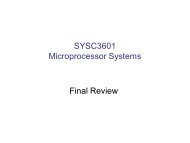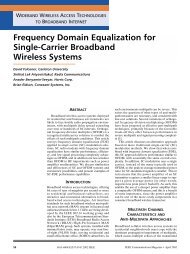Image Reconstruction for 3D Lung Imaging - Department of Systems ...
Image Reconstruction for 3D Lung Imaging - Department of Systems ...
Image Reconstruction for 3D Lung Imaging - Department of Systems ...
Create successful ePaper yourself
Turn your PDF publications into a flip-book with our unique Google optimized e-Paper software.
to noise however both algorithms produce useful 2D reconstructions at realistic noise<br />
levels.<br />
The ability <strong>of</strong> PD-IPM algorithm to reconstruct edges in <strong>3D</strong> models was not satisfactorily<br />
determined. The PD-IPM algorithm reconstructs the conductivity in the<br />
elemental basis. The complexity <strong>of</strong> the elemental solution limits the resolution <strong>of</strong><br />
the finite element model. Thus the capability <strong>of</strong> determining <strong>3D</strong> TV per<strong>for</strong>mance is<br />
limited to relatively coarse FEMs that may limit the per<strong>for</strong>mance <strong>of</strong> the algorithm.<br />
Further work is required to enable the solution <strong>of</strong> higher resolution <strong>3D</strong> models in order<br />
to evaluate the per<strong>for</strong>mance <strong>of</strong> PD-IPM <strong>for</strong> <strong>3D</strong> lung imaging.<br />
In summary, TV regularised reconstructions are considerably more expensive to calculate<br />
than quadratic reconstructions, however the TV PD-IMP algorithm is able to<br />
compute 2D non-smooth reconstructions in the presence <strong>of</strong> moderate noise, and is<br />
there<strong>for</strong>e <strong>of</strong> practical use in certain applications. It is not currently recommended <strong>for</strong><br />
use with <strong>3D</strong> lung imaging.<br />
The main contribution <strong>of</strong> this objective was the improvement in convergence <strong>of</strong> the<br />
PD-IPM algorithm and the evaluation <strong>of</strong> the algorithm’s per<strong>for</strong>mance in 2D and <strong>3D</strong><br />
applications.<br />
This work is described in the article “Total Variation Regularization <strong>for</strong> EIT,” by<br />
Borsic, Graham, Lionheart, and Adler. Chapter 7 is a copy <strong>of</strong> the a manuscript<br />
in preparation <strong>for</strong> submission to IEEE Transactions on Medical <strong>Imaging</strong>. This is a<br />
collaborative work. The development <strong>of</strong> the PD-IPM algorithm, it’s explanation and<br />
implementation are the original work <strong>of</strong> Andrea Borsic and can be found in [23]. The<br />
analysis <strong>of</strong> the algorithm’s per<strong>for</strong>mance, including the improvement in convergence,<br />
the simplification <strong>of</strong> the β decay schedule as well as the design and execution <strong>of</strong><br />
the algorithm’s per<strong>for</strong>mance evaluation and subsequent conclusions are the original<br />
contribution <strong>of</strong> this thesis. Dr Adler and Dr Lionheart are the PhD supervisors <strong>of</strong><br />
Graham and Borsic respectively.<br />
1.4.2 Miscellaneous Contributions<br />
The background research <strong>for</strong> this thesis is contained in chapters 2 and 3. These chapters<br />
include, in one place, the complete development <strong>of</strong> the finite element solution <strong>of</strong> the <strong>for</strong>ward<br />
problem from Laplace’s equation through to the finite element solution. We are unaware <strong>of</strong><br />
the existence <strong>of</strong> a similar end-to-end derivation elsewhere in the EIT literature.<br />
Numerical simulation <strong>of</strong> conductivity data permits the rapid development <strong>of</strong> imaging<br />
algorithms than would not be possible if researchers were restricted to only using lab data.<br />
However, many EIT papers rely strictly on simulated data to make conclusions. Scientific<br />
and engineering results based on simulations are valuable but must be verified with empirical<br />
(lab) data. There<strong>for</strong>e a collateral objective <strong>of</strong> this thesis is to verify simulated results with<br />
empirical data collected in our lab. Thus, where possible, the conclusions presented in this<br />
thesis are verified using the Goe-MF II adjacent stimulation tomography system (Viasys<br />
Healthcare, Höchberg, Germany).<br />
The impulse function and point spread function are basic tools <strong>of</strong> signal processing <strong>for</strong><br />
linear systems. Neither the impulse function nor point spread function are mentioned in the<br />
EIT literature perhaps because EIT is a non-linear modality. In this thesis pseudo-impulse<br />
phantoms are introduced and used with EIT. In section 4.3.5 we first introduce the Blur<br />
Radius measure which is an analog <strong>of</strong> the point spread function adapted <strong>for</strong> EIT using<br />
finite element meshes. The argument <strong>for</strong> the use <strong>of</strong> pseudo-impulse functions in algorithm<br />
6





